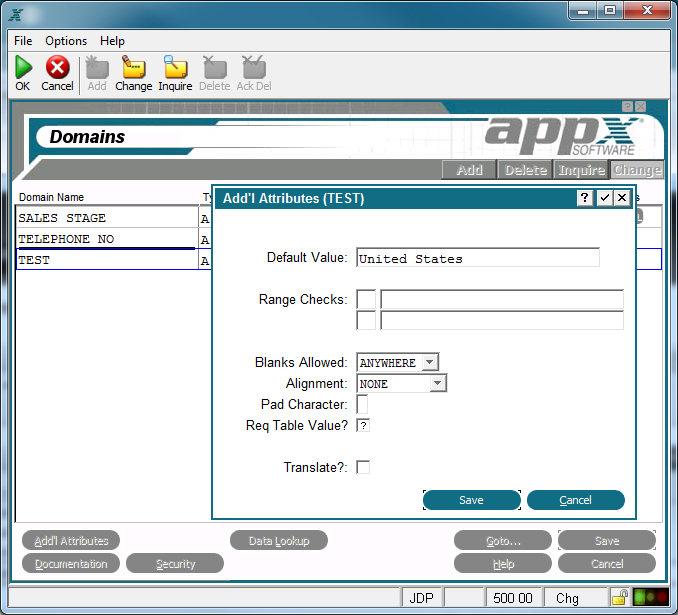Chapter 1-1: Overview of Application Design |
Alpha Domain Additional Attributes From the Alpha Domains overlay, you have an Additional Attributes option. The Alpha domain Additional Attributes overlay is shown below.
Alpha Domain Additional Attributes Overlay The Alpha Domain Additional Attributes Overlay contains the following fields: Default Value establishes a modifiable starting value for all image items whenever they are first displayed in add mode in an input image, unless modified by a user. If blank, there is no starting value displayed on the image. Range Checks defines a series of allowable values that APPX uses for online data validation. The first component represents the relation. The options are: EQ (equal to) NE (not equal to) GT (greater than) LT (less than) GE (greater than or equal to) LE (less than or equal to) IN (includes) The second component represents the value assigned to the relation. If you enter two relations, APPX infers an AND relationship. Blanks Allowed indicates whether or not blanks are permitted and, if so, where they can be placed. The Blanks Allowed options are:
TRAILING, Blanks are permitted only when positioned to the right of the far right-hand (non-constant) character in a field. Trailing constant characters are treated as trailing blanks for the purpose of applying this restriction. ANYWHERE, Blanks can be entered in any position within a field. The default is ANYWHERE. Alignment, determines whether or not data in a field is aligned for storage and/or display and, if so, the type of alignment. The Alignment options are: NONE, Data is not aligned for either storage or display purposes. LEFT, Data is aligned with the far left-hand character position in a field. RIGHT, Data is aligned with the far right-hand character position in a field. CENTERED, Data displays in the center of a field. JUSTIFIED, Data is aligned with both the far left-and right-hand character positions in a field, and distributed to occupy the entire field. Where necessary, data is padded with spaces. The default is NONE. |
Application Design Manual "Powered by Appx Software"154 ©2006 By APPX Software, Inc. All Rights Reserved |
